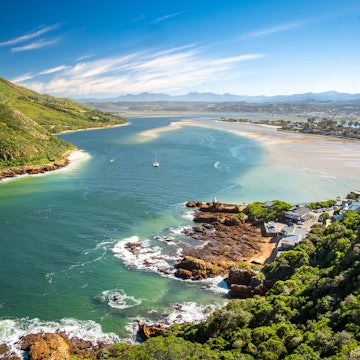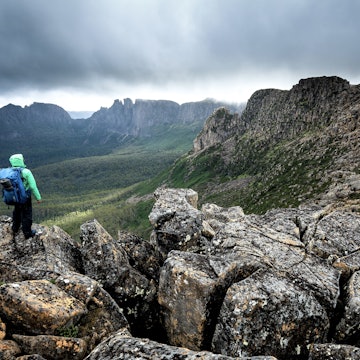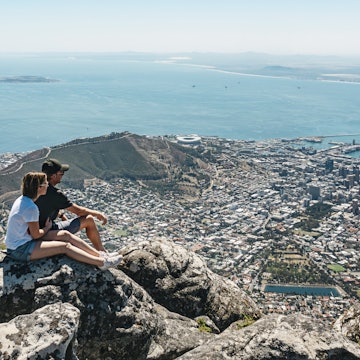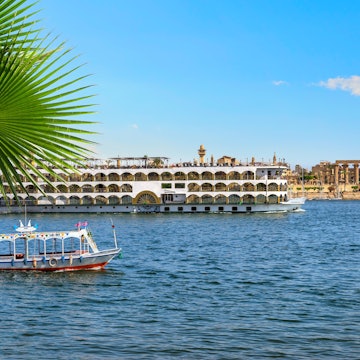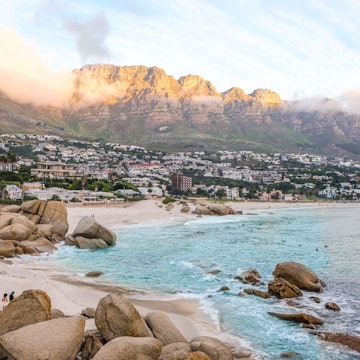
St Helena: a storied history told through the world’s most remote distillery

Sep 19, 2019 • 7 min read

The unbelievable landscapes of St Helena may have you rubbing your eyes with disbelief © Uwe Mosher / Getty Images
The St Helena Distillery, named after its island home, is the world’s most remote distillery. Not only is this the only maker of spiced rum and prickly pear schnapps between Southern Africa and Brazil, but its products are liquid summaries of the South Atlantic island’s history and environment.
Fancy a taste? Just hop on one of the new flights to St Helena and head into the hills to find the boutique distillery. It is a labour of patience as well as love for the Welsh distiller, who shipped his still, fermentation tanks and other equipment from Germany, and imports ingredients such as South African grape juice to make wine.

Shipwrecks and curfews
Established by Paul Hickling in 2006, the St Helena Distillery’s most popular product in the local pubs, which lubricate the population of 4500 ‘Saints’, is its spiced rum. The dark spirit is called White Lion – after the island’s most famous shipwreck, the Dutch East India Company vessel Witte Leeuw, which was said to have been sunk by two Portuguese carracks in 1613. More accurately, the ill-fated ship blew itself up during the scuffle, but either way, its cargo of 1300 diamonds was blasted to smithereens and generations of divers still haven’t found any booty in the silt.
The skirmish was typical of the ruthless competition between the trading fleets that plied the sea route around the Cape between Europe and the Far East. The Portuguese discovered St Helena in the early 16th century and kept it secret from their rivals, but Sir Francis Drake followed and the British East India Company claimed the island in 1657. The 120-sq-km island received 1000 ships a year until its fortunes declined with the opening of the Suez Canal in 1869, which shifted trade routes north.

During that maritime heyday, life on island was so raucous that St Paul’s Cathedral was built on a hill outside Jamestown due to the island's capital being overrun with taverns and brothels. As visitors learn on historic tours with Magma Way, several governors incited armed rebellions by attempting to reduce the consumption of alcohol, including the arrack once distilled from potatoes. Throughout the 18th century, measures to control the rabble of thirsty sailors, homesick soldiers, settlers and emancipated slaves included imposing a 10pm curfew, commanding British East India Company employees to attend church, banning the importation of spirits and asking prostitutes to leave the island.
Today, St Helena is more of a sleepy outpost than a den of iniquity, with less than a dozen pubs and the same number of inmates in Jamestown Prison. However, echoing its former bawdiness, the island’s favourite drink is the Shipwreck, a mixture of spiced rum and Coke. Ask for a White Lion Shipwreck – especially in Jamestown’s Standard Bar, run by Paul’s islander wife, Sally.
Napoleon's demise
After the British Crown took over management of St Helena from the British East India Company, the Brits began a long tradition of exiling troublesome adversaries to the far-flung island. Consequently St Paul’s Cathedral houses the graves of British officers who died in the typhoid epidemic that swept two POW camps holding 6000 Boers, sent here during the Anglo-Boer War (1899-1902), and two infant children of Zulu king Dinuzulu who spent most of the 1890s here. There is also a dedicated Boer Cemetery, the last resting place of 180 South Africans, with a memorial listing their names.
St Helena’s most famous exile was Napoléon Bonaparte, who spent the last five years of his life drinking sweet wine and dictating his military memoirs in the grand Longwood House. The celebrated sweet wine was made in Constantia, Cape Town and imported to St Helena on British East India Company ships to console the Emperor.
Various events mark Napoleon’s stay on island from 1815 to 1821, and St Helena Tourism is even recruiting a Napoleon impersonator to appear at bicentennial celebrations from October 2019 onwards. Paul is ageing two barrels of brandy for 2021, the 200th anniversary of the Frenchman’s death, when he plans to release 2000 small bottles. Until then, you can channel the spirit of Napoléon by taking the audio tour at Longwood and the Briars Pavilion, where he spent his first two months on island, and visiting his unmarked (and empty) tomb.

Prickly pears and exotic imports
Formerly an electronic engineer, Paul learnt the art of distillation in Germany, where he was inspired to make a Saint version of fruit schnapps. ‘I asked what fruit we have in abundance here, and the answer was tungi,’ he says. The resulting fruity spirit made from tungi, as prickly pears are known on St Helena, is best drunk treacly from the freezer or mixed with orange juice.

Tungi is in many ways the quintessential alcoholic souvenir of St Helena, as it encapsulates the island’s natural and social history. The St Helena National Trust, which offers guided walks to the island’s windblown peaks and promontories, works hard to conserve the endemic flora and fauna – most famously the wirebird, a thin-legged plover – amid the arrivals on boats from Africa. Incomers have included prickly pears and other succulents, the termites that demolished Jamestown in the 19th century and the elusive simian-feline ‘Monk-Cat’, thought to be a civet that stowed away on a boat bringing building materials for the 1½-year-old airport.
The word tungi itself, meanwhile, is typical of the Saints patois, a fast-spoken English riddled with slang and contractions that can be incomprehensible to outsiders. Much like their dialect, the mixed-race Saints themselves are the products of folk who came from far and wide with the trade winds. Locals can trace their roots to centuries of incomers, including British soldiers, sailors, liberated African slaves, indentured Chinese and Indian workers and Boer prisoners.

Coffee at a cost
The distillery’s Midnight Mist Coffee Liqueur is a Kahlúa-like concoction of rum and coffee grown on the fertile island’s rocky slopes. Picked by hand, St Helena coffee beans are among the world’s most expensive, which you can buy in gift shops (£10 for 200g) or taste by the cup at the coffee shop in Jamestown Harbour. Even haughty Napoléon was a fan, drinking a few cups a day and describing it as the only good thing about St Helena.
The beans are considered special because they are pure descendants of the green-tipped Bourbon arabica seeds imported by the British East India Company from Mocha, Yemen in 1733. Limited amounts of this black gold are found abroad, with some occasionally being offered by Harrods and the Sea Island coffee merchants in London, and Starbucks Reserve in Seattle. It’s possible to take a tour of the cultivation, harvesting and roasting process at the Rosemary Gate plantation.

Capital in a canyon
The last product in the distillery’s fluctuating range of spirits is Jamestown Gin, the world’s only gin made from the infusion of rare Bermuda juniper, which grows on St Helena. The spirit is named after the island's capital, which distinctively occupies a canyon with roads climbing the rocky sides to the green hinterland.
Named in turn after King James II's reign, Jamestown’s most famous feature is the 699-step Jacob’s Ladder, built in 1829 to haul manure up and send goods down. Tackling the vertiginous staircase is a rite of passage for visitors, while Saints can all tell stories of sliding down its railings on their way home from school or trudging up after a few Shipwrecks in Jamestown’s pubs.

Make it happen
Airlink flies from Johannesburg to St Helena Airport on Saturdays, with midweek flights from Cape Town recommencing in December 2019. The Tuesday flights start 3 December and run until 25 February. Most Western nationals do not need a visa to visit St Helena, but you must pay a £20 immigration fee and show your medical insurance and return flight. St Helena and British Pounds are both accepted on island, but there are limited credit and debit card facilities, and rental car is the easiest way to travel around. Accommodation includes Jamestown’s Consulate and Mantis St Helena, Bertrand’s Cottage at Longwood and Richard’s Travel Lodge in St Paul’s. Contact the distillery to arrange a tasting.







